Outsourcing Statistics 2024 – By Country, Industry, Reasons, Benefits And Facts

Page Contents
- Introduction
- Editor’s Choice
- Effectiveness of Outsourcing
- Facts About Outsourcing
- Outsourcing Statistics by States
- Services That are Mostly Outsourced
- Outsourcing Statistics by Industry Types Outsource
- U.S. Companies That Outsource
- General Outsourcing Statistics
- Positive Outcomes of Outsourcing
- Modes of Outsourcing Communication Statistics
- Reasons of Outsource Growth in the U.S.
- Benefits of IT Outsourcing
- Recent Developments In Outsourcing
- Conclusion
Introduction
Outsourcing Statistics: In today's global economy, outsourcing plays a pivotal role in business operations, offering companies cost-effective solutions and access to specialized expertise. Recent statistics shed light on the widespread adoption and impact of outsourcing. According to data from Statista, the global outsourcing market was valued at USD 92.5 billion in 2021, with a projected growth rate of 5.84% from 2022 to 2028. Furthermore, a report by Deloitte revealed that 59% of companies outsource to cut costs, while 57% outsource to focus on core business functions.
These figures underscore the significant role outsourcing plays in modern business strategies, driving efficiency and enabling organizations to stay competitive in a rapidly evolving landscape. As we delve deeper into outsourcing statistics, it becomes evident that its influence extends across industries and geographies, shaping the way businesses operate and thrive in today's interconnected world.
Editor’s Choice
- The global spending on outsourcing surged to approximately USD 731 billion in 2023, reflecting its significant economic impact and widespread adoption across industries.
- An overwhelming 92% of G2000 companies leverage IT outsourcing services, emphasizing the prevalent reliance on outsourcing to meet technological needs.
- Business process outsourcing contributes significantly to the Philippines' economy, accounting for 9% of its GDP, highlighting the country's pivotal role in the outsourcing landscape.
- Approximately 37% of small businesses outsource at least one business process, demonstrating the accessibility and benefits of outsourcing for organizations of varying sizes.
- China's services outsourcing industry witnesses a substantial influx of over one million new employees annually, indicating the sector's robust growth and employment opportunities.
- The global outsourcing industry was valued at USD 620.381 billion in 2020 and is projected to reach USD 904.948 billion by 2027, showcasing its continuous expansion and market potential.
- India, known as the “Outsourcing Capital of the World,” excels in various outsourcing domains, including IT services, software development, customer support, and back-office operations, leveraging its abundant talent pool and technological expertise.
- Southeast Asian countries like Malaysia, Vietnam, and Thailand specialize in IT outsourcing, business support functions, and digital marketing, offering competitive solutions to global businesses.
- The US market dominates the global outsourcing business, generating USD 62 billion of the total international income from the industry, underscoring its significance in the global outsourcing landscape.
- Information technology remains the most outsourced industry, with 37% of IT operations being outsourced, highlighting the sector's reliance on outsourcing for specialized services and expertise.
- The outsourcing industry is anticipated to witness a compound annual growth rate of 4% between 2021 and 2025, indicating steady expansion and opportunities for market players.
- Since the pandemic, 45% of businesses have expressed intentions to increase outsourcing, emphasizing the growing importance of outsourcing in business strategies, particularly in accessing specialized skill sets and enhancing efficiency.
- Cloud computing has opened up more outsourcing opportunities, with 90% of businesses able to leverage remote professionals, indicating the transformative impact of technology on the outsourcing landscape.
You May Also Like To Read
- Business Intelligence Statistics
- Networking Statistics
- Diversity in Tech Statistics
- Robotics Industry Statistics
Effectiveness of Outsourcing
- This generates jobs and stimulates economic growth in the United States and other nations too.
- Allows for product specialization, monopolization, innovation, and development and gives US businesses access to achieve a bigger skill pool.
- The outsourcing of American business to different other nations allows for enhancing international investments which improves the living standards.
- Both the U.S. and the other countries benefit from a growing economy.
- Thus, North America led the market in 2022 with the highest 47% revenue share.
Facts About Outsourcing
- Outsourcing is a prevalent business practice where companies delegate tasks to external service providers to reduce costs and focus on core activities.
- According to Statista, the global outsourcing market reached approximately USD 92.5 billion in 2021, indicating its significant economic impact and widespread adoption.
- Companies across various industries outsource a range of functions, including IT services, customer support, and back-office operations, to specialized service providers.
- Outsourcing allows businesses to access skilled professionals and advanced technology without the need for significant investment in infrastructure or hiring additional staff.
- The Philippines has emerged as a prominent hub for business process outsourcing (BPO) and call centers, contributing 9% to its GDP.
- India, often referred to as the “Outsourcing Capital of the World,” excels in IT services, software development, and knowledge-based services, leveraging its vast talent pool and cost-effective solutions.
- Cloud computing and Robotic Process Automation (RPA) are rising trends in outsourcing, offering flexibility, cost-efficiency, and enhanced security.
- The US market dominates the global outsourcing business, generating a substantial portion of the total international income from outsourcing services.
- According to Technavio, the IT outsourcing market is projected to grow by USD 98 billion during the period of 2020-2024, indicating sustained growth and opportunities in the sector.
- Businesses worldwide continue to embrace outsourcing as a strategic approach to streamline operations, access specialized expertise, and remain competitive in the global marketplace.
- Regionally, 42% of foreign outsourcing purchasers come from North and South America.
- About 300,000 jobs are outsourced by US companies annually.
- As of 2023, 286,881 enterprises providing business process outsourcing services in the US with a 3.7% growth since last year.
- Among US companies, 29% use outsourcing with below 50 employees.
- Out of the total overseas revenue, USD 70.66 billion was generated by the U.S. market by the end of 2022.
- Business process outsourcing's revenue in the U.S. is expected to reach USD 129.70 billion in 2023.
- IT Outsourcing's revenue is predicted to reach USD 156.20 billion by 2023.
- By 2023, it is expected that the business process outsourcing segment's average spend per employee would reach USD 0.77k.
- BPO includes a wide range of business operations either in the front or back office such as call centers for customer service or the back office for human resource departments.
- In 2022, due to the widespread use of cloud computing in the U.S. market business process outsourcing has undergone major modifications.
Outsourcing Statistics by States
States in the US with the highest percentage of businesses providing business process outsourcing in 2022.
- California = 25,393
- Florida = 18,650
- Texas = 12,876
Services That are Mostly Outsourced
- IT and accounting services = 37% and IT is expecting to gain $397 billion by the end of 2025.
- Customer services are expected to reach $81.5 billion by the end of 2023.
- Back office
- Human resource services = 24%
- Digital marketing = 34% and is expected to reach $81.5 billion by 2023.
- Payroll services
- Other development related services = 29%
- Healthcare services are expected to reach $229.2 billion.
- Retail and financial services
Outsourcing Statistics by Industry Types Outsource
- Education = 11%
- Healthcare = 9%
- Construction = 8%
- Information services = 5%
- Finance and insurance = 5%
- Agriculture = 4%
- Marketing and sales = 4%
- Software =4%
- Art and entertainment = 4%
- Retail = 4%
- Telecommunication = 3%
- Technical services = 2%
- Others = 11%
U.S. Companies That Outsource
- In 2022, the number of businesses involved in outsourcing was 2,75,397
- As of 2023, the involvement increased by 3.7% which turned to 2, 86,881.
- The top 10 companies that outsource the most are Google, Facebook, Apple, Microsoft, IBM, Slack, Wells Fargo, LinkedIn, American Express, and WhatsApp.
General Outsourcing Statistics
- Employee spending on IT outsourcing is projected to average USD 132.10 billion in 2023.
- By 2028, this spending is expected to skyrocket to USD 777.70 billion, growing at a remarkable compound annual growth rate (CAGR) of 11.07%.
- In 2023, the United States is poised to contribute the most significant portion of the market's revenue, with an anticipated USD 167.90 billion.
- The main reason for U.S. business outsourcing is to balance the expenses and the economy is 70%
- 64% of leading American companies are depending on digital enablers known as Robotic Processing Automation.
- In 2022, at least some of the work will be outsourced by 80% of small and 128% of large enterprises.
- In the US, there are 59 million freelancers.
- In the US, 68% of large businesses outsource.
- Around 36% of American workers are termed gig workers.
- 58% of companies have adopted Artificial Intelligence.
- 80% of American manufactured goods are outsourced.
- American banks outsource almost 40% of help desk positions.
- 68% of the accounting and IT services of U.S. businesses are outsourced mostly to low-income countries.
- To assist sustainability and business-related expansion, 19% of U.S. organizations use outsourcing in 2022.
Positive Outcomes of Outsourcing
- Promotes greater flexibility along with effective adaptability = 21%
- Allow in increasing efficiency = 19%
- Enhance resources = 16%
- Reduced employee's time for doing other projects = 11%
- Received proper guidance and help from experts = 10%
- Enables better risk management facilities = 9%
- Cheaper than hiring office employees = 7%
- Process better tax breaks = 6%
- The supply chain segment has increased at the fastest rate by more than 8%.
Modes of Outsourcing Communication Statistics
- Email = 25%
- Video conference = 25%
- Phone calls 20%
- Instant messaging = 17%
- Project management board = 12%
Frequency of communication
- On monthly basis = 8%
- Weekly = 38%
- Daily =53%
Reasons of Outsource Growth in the U.S.
- At the end of 2021, More than 500,000 new positions become available because of a huge proportion of retirement and due to the lowest birth rate.
- The U.S. immigration rate has also been reduced.
- In 2022, many U.S. startups and SMEs faced funding challenges.
- The payroll expenses raised an average of 3.9%.
- The number of resigned employee's number increased to 4.5 billion.
- In 2022, new jobs opened = 1.6 million.
- Employee hired = 6.7 million
Benefits of IT Outsourcing
- Cyber security services remained in high demand; in 2022 almost 51% have hired employees.
- Machine learning automation has been adopted by IT outsourcing providers, which has increased service quality.
- 90% of consumer interactions have been managed by chatbots (part of Artificial Intelligence) by 2022.
- The system of remote work turned out to be a normal process.
- Outsourcing has reduced labor costs in the United States.
- The Internet of Things ensured new opportunities for outsourcing.
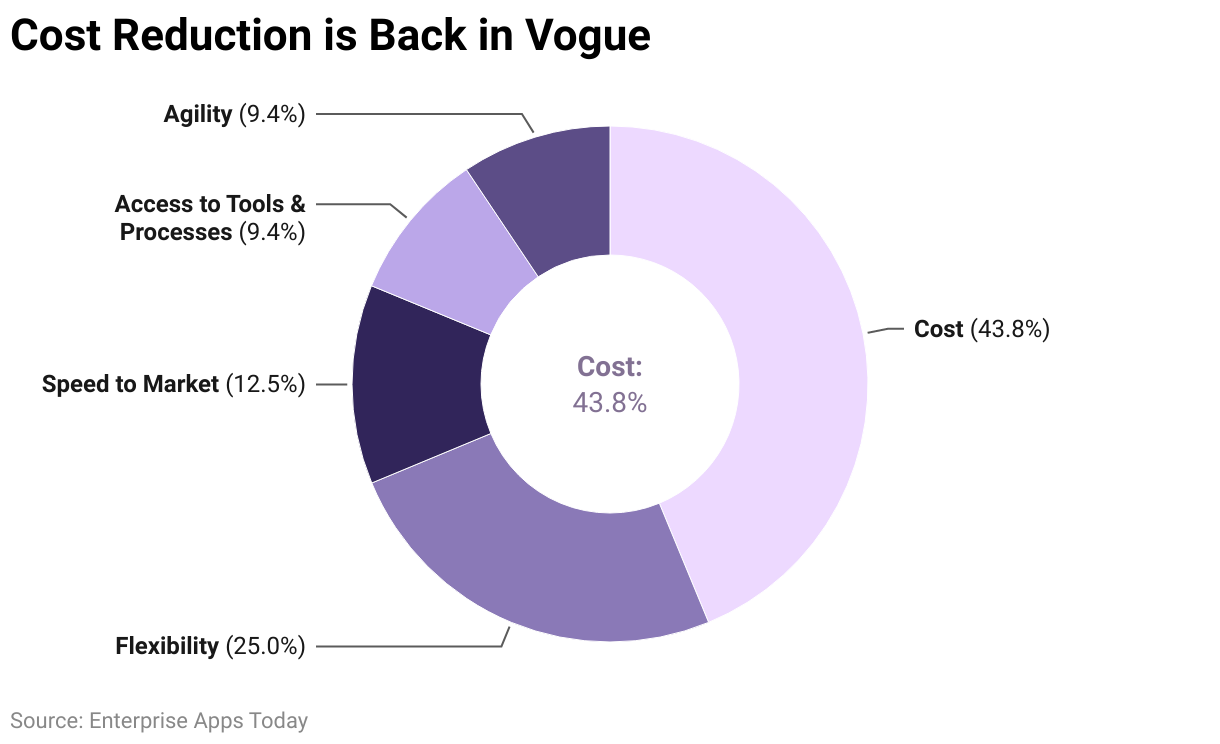
(Reference: ardem.b-cdn.net)
The above graph explains the benefits or reasons for outsourcing, in which cost reduction plays an effective role followed by flexibility, ensures speed to market growth, allows proper access to tools and processes, and promotes agility.
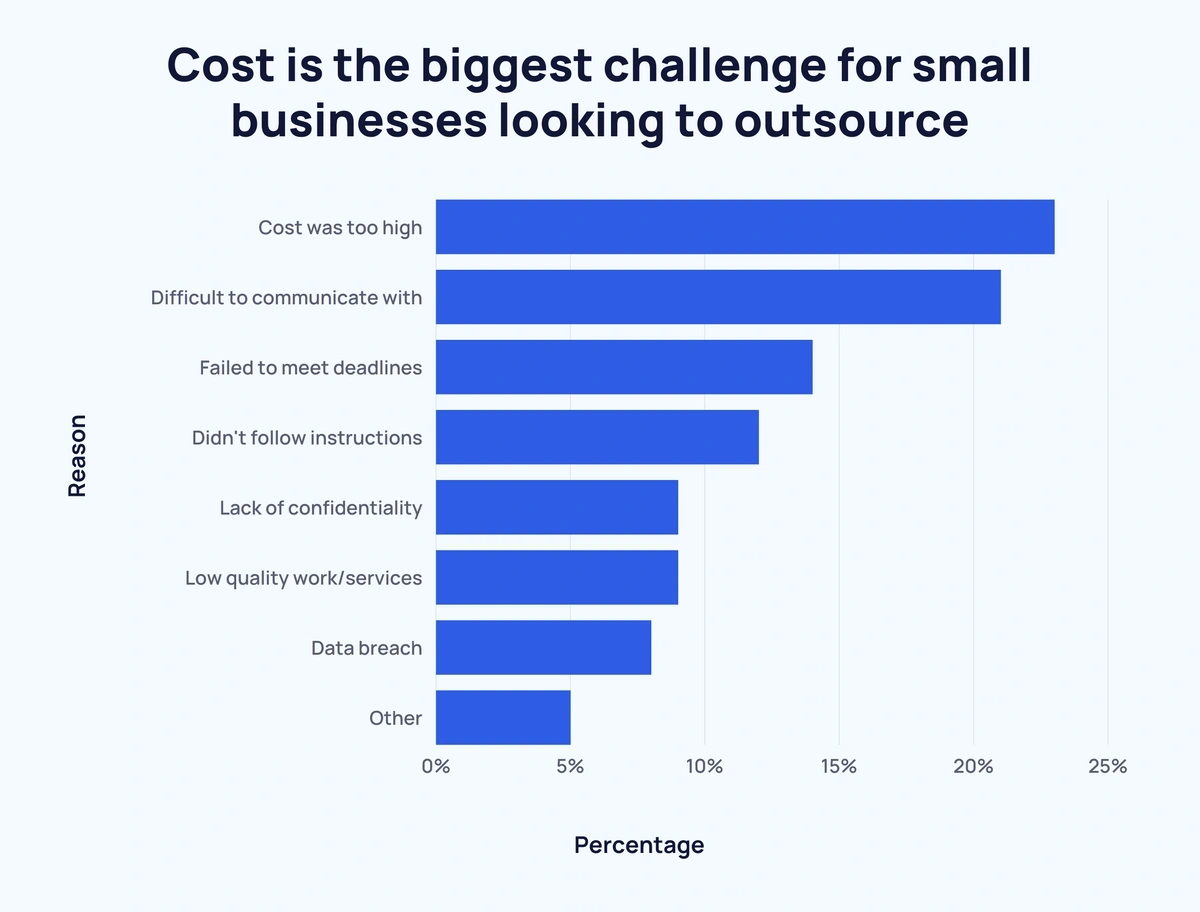
(Source: cdn.buttercms.com)
- The above chart describes a few reasons the U.S. small businesses were not able to outsource as expected in 2022.
- According to a survey, 23% of businesses stated that high prices remained the largest obstacle.
- 21% of businesses faced problems in communicating with outsources.
- 14% of business organizations were not able to complete their work on an appropriate timeline.
- 12% didn’t follow proper rules and instruction of respective outsources.
- 9% failed due to lack of confidentiality and another 9% because of low quality and work services.
- 8% due to data breaches and 5% covers other reasons
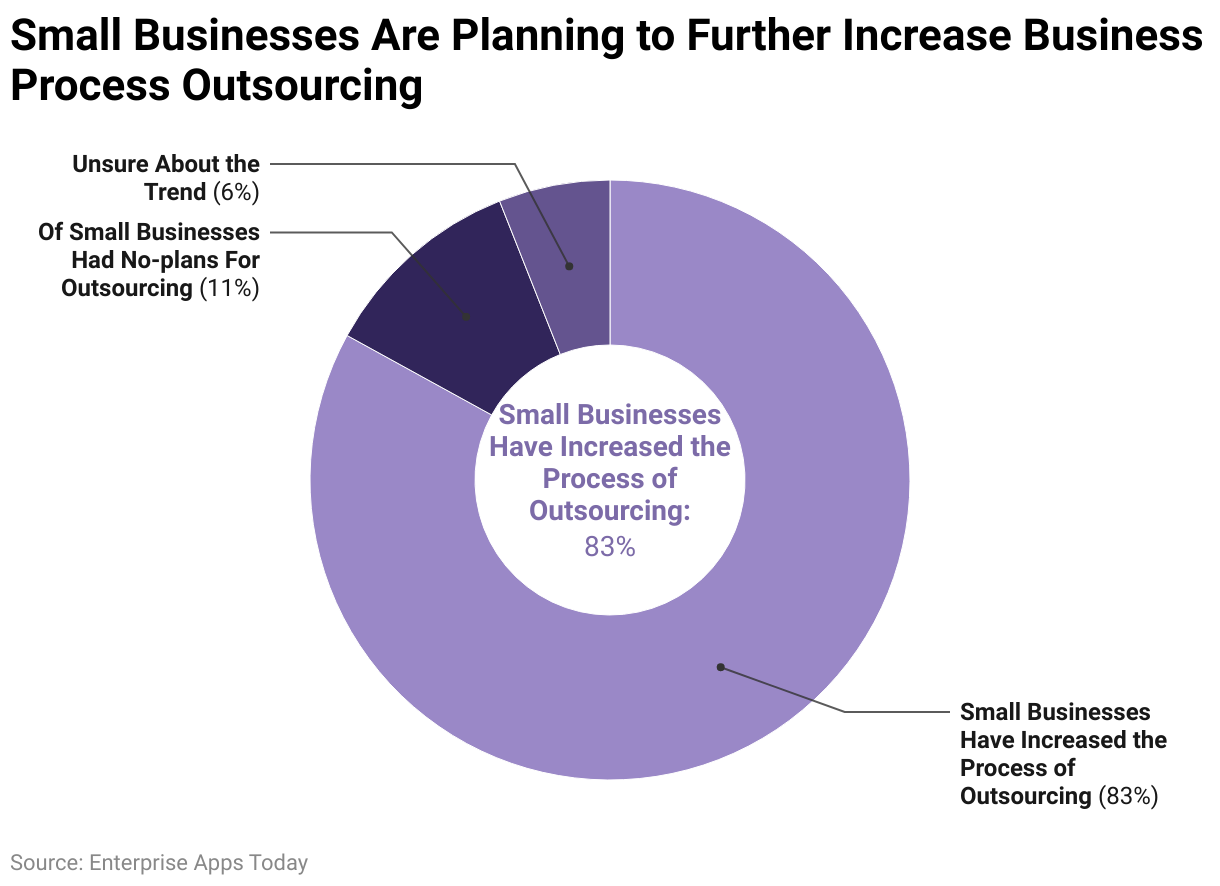
(Reference: images.upcity.com)
- The above graph depicts that in 2022; around 83% of U.S. small businesses have increased the process of outsourcing.
- 11% of small businesses had no plans for outsourcing.
- 6% remained unsure about the trend.
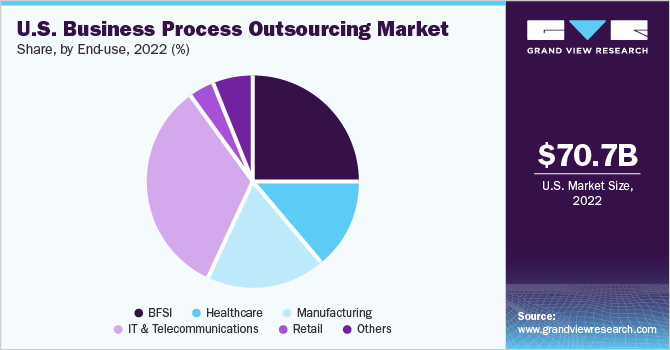
(Source: grandviewresearch.com)
- The above pie chart describes the United States outsourcing market share by the end of 2022.
- In 2022, the IT & telecommunications segment produced around 34.0% of the market as a whole, accounting for the highest revenue share.
- As a result of the widespread use of cutting-edge technology and the existence of major players in North America, the markets of BFSI have achieved healthy development. The outsourcing process in driving growth by 36% in the BFI sector annually.
- During the forecast period of 2022 to the next 5 years, the U.S. healthcare outsourcing market is expected to grow at a CAGR of 8.11%.
- Out of the total overseas revenue, $70.66 billion was generated by the U.S. manufacturing market by the end of 2022, followed by retail and others.

(Reference: images.upcity.com)
The above graph shows business years of working for outsourcing in the United States.
- 10 years = 35%
- 6-9 years = 12%
- 3-5 years = 31%
- 1-2 years = 35%
- Less than 1 year = 14%
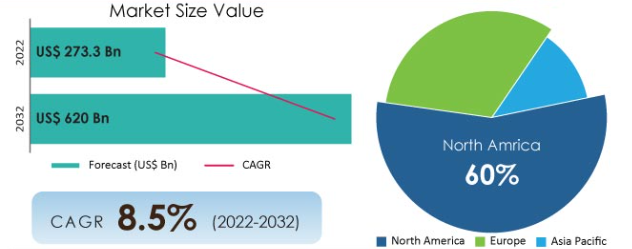
(Source: factmr.com)
- The overall market size of the outsourcing market in 2022 was $273.3 billion, out of which 60% is covered by North America.
- Out of the total outsourcing process, 57% is IT and telecommunication.
- 3/5th of the market is dominated by the outsourcing process in America in 2022.
- The average cost of HR outsourcing was $ 45-1500 / month.
- For IT outsourcing was $110-160 / month.
Recent Developments In Outsourcing
- Many companies are increasingly turning to nearshore outsourcing, opting for service providers in nearby countries to reduce operational costs and improve collaboration.
- The COVID-19 pandemic has accelerated the adoption of remote outsourcing, with businesses leveraging digital tools and communication platforms to facilitate seamless collaboration with offshore teams.
- There is a growing trend towards selective outsourcing, where companies choose to outsource specific tasks or functions rather than entire processes, allowing for greater control and customization.
- Outsourcing providers are increasingly focusing on providing value-added services such as analytics, automation, and cybersecurity to meet the evolving needs of their clients.
- Hybrid outsourcing models, combining elements of both onshore and offshore outsourcing, are gaining popularity as companies seek to balance cost-effectiveness with proximity and cultural alignment.
- Outsourcing contracts are becoming more flexible, with shorter durations and greater emphasis on outcomes rather than processes, enabling businesses to adapt quickly to changing market conditions.
- Emerging technologies such as artificial intelligence, machine learning, and blockchain are being integrated into outsourcing solutions to drive efficiency and innovation.
- There is a growing emphasis on sustainability and ethical sourcing in outsourcing, with companies prioritizing providers with strong environmental and social responsibility practices.
- The outsourcing industry is witnessing consolidation, with larger providers acquiring smaller firms to expand their service offerings and geographic reach, leading to increased competition and market consolidation.
- Outsourcing providers are investing in upskilling their workforce and developing talent pipelines to address skill gaps and meet the evolving demands of clients in an increasingly digitalized world.
Conclusion
After covering up the article on outsourcing statistics it can be stated recent data underscores the substantial economic impact and widespread adoption of outsourcing across industries. With the global spending on outsourcing projected to soar to USD 777.70 billion by 2028 at a notable CAGR of 11.07%, it's evident that organizations continue to recognize the value of external partnerships in achieving operational efficiency and accessing specialized expertise. The anticipated contribution of USD 167.90 billion from the United States alone in 2023 highlights the country's pivotal role in driving the outsourcing market's growth.
These statistics underscore the strategic importance of outsourcing in modern business strategies, enabling companies to streamline operations, optimize costs, and remain competitive in an increasingly interconnected global economy. As businesses navigate through evolving market dynamics and technological advancements, outsourcing emerges as a key enabler of agility, innovation, and sustainable growth in the years ahead.
Sources
FAQ.
The practice of looking for an outside party to whom you can assign parts of your business's processes is known as outsourcing.
This allow in increasing efficiency, increase concentration on key business operations, promotes competitive advantages, helps in reducing cost factor and allow in gaining higher reach in outsourcing process.
The majority of jobs in the globe are outsourced to the US, where about 68% of businesses outsource their services.
Information technology, customer service, human resource, finance, etc.

Barry is a lover of everything technology. Figuring out how the software works and creating content to shed more light on the value it offers users is his favorite pastime. When not evaluating apps or programs, he's busy trying out new healthy recipes, doing yoga, meditating, or taking nature walks with his little one.